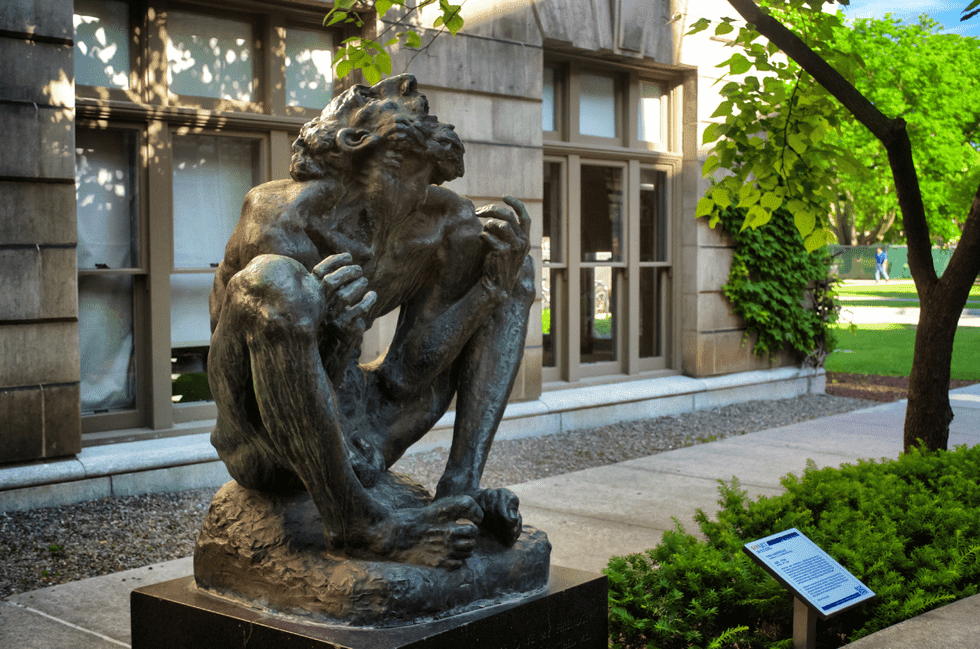Job
"Job" by Ivan Meštrović , 1945
Job is a bronze sculpture by Croatian artist Ivan Meštrović. The sculpture is located in the Mestrovic Sculpture Court. Situated on the northeast side of the Quad between Shaffer Art Building and Bowne Hall, this court features several sculptures by Meštrović, including Job, Moses, and Supplicant Persephone. Job stands 49 x 40 inches and features a nude man sitting on a rock in a posture of invocation. The man is looking upwards with his mouth open and his hands and feet curled. The man’s body is bony, his collarbone visible, and his stomach appears empty. The man is clearly suffering. Despite his cries to God for help going unanswered, the man is unwilling to abandon his faith.
Meštrović first had the idea for Job while being imprisoned by the Gestapo in Savska Cesta due to his political leanings in 1941. During his imprisonment, Meštrović felt intense feelings of resentment, resignation, loneliness, and hope, but had no means through which to express these feelings besides drawings. The suffering of the biblical figure Job resonated with him and he composed several drawings of Job during this period. In the sculpture, Meštrović sought to express the suffering he experienced during the Second World War. At the same time, Meštrović wanted to convey hope, as evident in the figure’s wide open eye.
Ivan Meštrović was a Croatian-American sculptor born August 15, 1883 in Vrpolje, Slavonia to poor Croatian parents. At the age of fifteen, Meštrović began an apprenticeship with a master of stonemasonry. In 1889, he was accepted to the Vienna Academy where he remained until 1904. Meštrović was forced to flee Split on the eve of the Austro-Hungarian attack in 1914. Alongside Anton Trumbic and Frano Supilo, he formed the Yugoslav Committee on National Independence in London. Meštrović was also imprisoned by the Gestapo in 1941 due to his political leanings. With assistance from the Vatican, he was released in 1942. Meštrović's early work often portrayed local Croatian legends and his later works often had strong biblical themes. In 1947, Meštrović moved to the US where he secured a sculptor-in-residence with Syracuse University until 1955. During his time at Syracuse he became a US citizen. He then took a position as Professor of Sculpture at University of Notre Dame in South Bend, Iniana. Meštrović had over 50 exhibitions during his lifetime. Some have considered him a modern day Michangelo. He designed his estate in Split, Yugoslavia (now in Croatia) which was donated by him to the people of Croatia and serves as a museum containing over 50 sculptures and multiple drawings of his work to this day. Ivan Meštrović died on January 16, 1962 in South Bend, Indiana.
Burton, R., & Pitoniak, S. (2019). Forever Orange: The Story of Syracuse University. SU Press; Tatham, D. (1997). "Ivan Mestrovic in Syracuse, 1947-1955." The Courier; SU University Archives; Schmeckebier, L. F. (1959). .Ivan Meštrović sculptor and patriot by Syracuse University Press; "Ivan Mestrovic - Job." (2018). Ivan MIM Mestrovic YouTube Channel. The editors of Encyclopaedia Britannica. :Ivan Meštrović." Encyclopaedia Britannica; "The History of the Institution." Ivan Meštrović Museums. Archived 2013-04-29 at the Wayback Machine; SU Art Galleries; SU Photo and Imaging Center.



